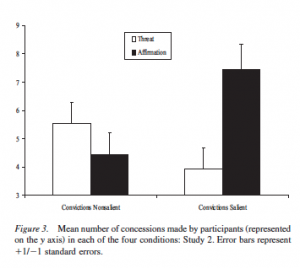Affirmation’s Effect on Concession During Political Negotiations
1. What They Did – Intervention Summary:
Participants were paired face-to-face with a real person whom they believed to hold an opposing belief on an issue about which they cared deeply. These people were, in fact, confederates — they played the role of an adversary and offered arguments and proposals to the study participants.
Participants were first asked to write an essay either affirming or threatening a source of self-integrity unrelated to the issue at hand. Upon completion of their essay, each participant was asked to indicate his or her mood on a scale from -3 (extremely negative or unhappy) to +3 (extremely positive or happy).
The participants were given some background material and copy of a proposed abortion bill. They were told that they would be playing the role of a Democratic Party State Legislator and that they would be matched with someone playing the role of a Republican Party State legislator to debate the bill. Half the participants had their beliefs affirmed while half had their beliefs threatened. Within those two groups, half of the participants had salient convictions and half had non-salient convictions. They then entered a room with their opposing legislator and debated the bill for 10 minutes before self-reporting their mood again.
An evaluation was then performed on the concessions that each person made toward changes in their initial demands. The number of original stipulations each participant was willing to surrender was accounted for for each set of participants and then compared for the self-affirmed vs. threatened participants.
2. What They Found – Results:
Study 2 discovered important information about the concessions (instances of acceptance of changes to the bill from the initial proposal to the final agreement) made by its participants.
The figure below demonstrates the concession data found in the study. Most importantly, results show that participants in the self-affirmation condition of the convictions salient section of the study offered more concessions than those in the threat condition.
This means that the participants who had an alternative source of self-integrity affirmed at the beginning of the study found it easier to concede some of their initial demands than the participants who had their self-integrity threatened.
Self-affirmed participants were more likely to see concessions as attempts to find common ground than as hard negotiation and appeared to feel more charitable and willing to compromise.
The participants all had to rate their confederate opposers after the debate and those whose beliefs were affirmed rated their opponents higher than threatened participants did. So, not only did self-affirmed participants concede more points, but they actually thought more highly of their adversaries.
This demonstrates potential for long-term effects as well, such as for preserving amicable relations.
3. Who Was Studied – Sample:
35 total undergraduate students —29 female and 6 male.
4. Study Name:
Cohen et al. 2007, Study 2
5. Citation:
Cohen, Geoffery L., David K. Sherman, Anthony Bastardi, Lillian Hsu, Michelle McGoey, and Lee Ross. “Bridging the Partisan Divide: Self-Affirmation Reduces Ideological Closed-Mindedness and Inflexibility in Negotiation.” Journal of Personality and Social Psychology 93.3 (2007): 422-24. Ed.stanford.edu. Stanford University. Web.
6. Link
https://ed.stanford.edu/sites/default/files/bridging_divides1.pdf.
7. Intervention Categories:
Contact, perspective
8. Sample Size:
35
9. Central Reported Statistic
“In the case of participants in the convictions salient condition, those in the self-affirmation condition offered more concessions (adj. M 7.43) than those in the threat condition (adj. M 3.94), t(29) 3.28, p .003.”
10. Effect Size:
Self-Affirmation: M = 7.43
Threat: M = 3.94
p = .003

